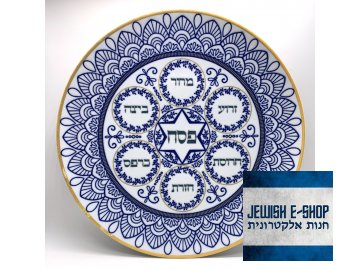Seder plates
Bestsellers

Diameter of the plate 30 cm, weight 1000 grams, special relief print on porcelain (the decor is raised a millimeter) with glaze, edges of the plate with the patina of the old...
Seder plate is a special kind of plate used at the Seder dinner during the Jewish holiday of Passover.
Seder plate (hebrew: קערה, ke’era, tj. decorativ plate) i special type of decorativ plate, use during Seder feast. It serves six traditional dishes, which symbolically remind us of the Passover story- maror, karpas, charoset, beitza, zeroa, salt water.
Maror (מרור) are bitter herbs, reminiscent of the bitterness of slavery that our ancestors experienced in Egypt. In the Czech environment, horseradish or salad are mostly used.
Karpas (כרפס) is a vegetable reminiscent of the poor diet of slaves. It should also be a spring crop. This is especially true of potatoes in Central Europe.
Karpas soaks in salt water (מים), which symbolizes the sweat and tears of slaves.
Charoset (חרוסת) is also reminiscent of slavery. It is a mixture of grated apples, raisins, nuts, cinnamon, honey and sometimes red wine (there are many recipes). It symbolizes the mortar with which our ancestors built houses in Egypt.
Zeroa (זרוע) is a bone, referring to the sacrificial lamb (קרבן פסח). Roasted chicken bone is often used instead of ram bone.
Beitza (ביצה) is roasted egg, which is symbolic for two reasons: It mainly represents a new life, but also the people of Israel, which, like the yolk, does not merge with the protein, it has not merged with other nations in Egypt in the past.
Seder plates are produced in various designs from a number of materials (ceramics, glass, porcelain, silver, brass, etc.).






